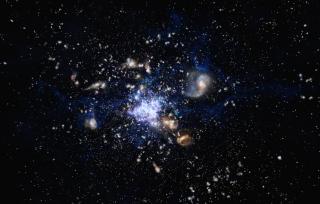Bibcode
Gowardhan, A.; Riechers, D.; Pavesi, R.; Daddi, E.; Dannerbauer, H.; Neri, R.
Bibliographical reference
The Astrophysical Journal, Volume 875, Issue 1, article id. 6, 6 pp. (2019).
Advertised on:
4
2019
Journal
Citations
34
Refereed citations
33
Description
We report NOrthern Extended Millimetre Array (NOEMA) observations of
warm molecular gas traced by CO(5 ‑ 4) in a z∼ 3.2 gas-rich
main-sequence (MS) galaxy, initially serendipitously detected in CO(3
‑ 2) emission in “blind” deep NOEMA observations. Our
target shows a gas excitation consistent with that seen in z∼ 1.5 MS
galaxies ({L}CO(5-4)}{\prime }/{L}CO
(3-2)}{\prime }=0.41+/- 0.14), albeit toward the low end, as
well as a similar star formation efficiency based on the CO(3 ‑ 2)
line luminosity and the {L}IR}. However, it shows a high
molecular gas fraction ({f}gas}=0.9+/- 0.2) as compared to
z∼ 1.5 MS galaxies ({f}gas}∼ 0.42), consistent with a
cosmologically increasing gas fraction beyond z≳ 3 and our current
understanding of scaling relations between z, {f}gas}, the
stellar mass M *, and the specific star formation rate. Our
results are consistent with recent findings by the COLDz and ASPECS
molecular line scan surveys, and suggest that deep searches for CO
emission are a powerful means to identify gas-rich, star-forming
galaxies at high redshift.
Related projects

Molecular Gas and Dust in Galaxies Across Cosmic Time
Two of the most fundamental questions in astrophysics are the conversion of molecular gas into stars and how this physical process is a function of environments on all scales, ranging from planetary systems, stellar clusters, galaxies to galaxy clusters. The main goal of this internal project is to get insight into the formation and evolution of
Helmut
Dannerbauer